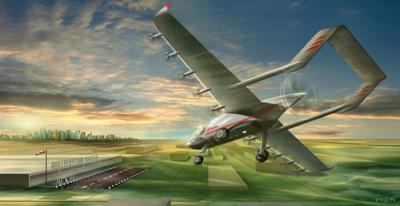Wed, Jun 10, 2020
The Single-Pilot eSTOL Carries 500 Pounds of Cargo -- Off 300 Foot Runways
Airflow is developing their first electric Short Take-Off and Landing (eSTOL) aircraft designed for middle-mile logistics. Airflow’s aerial logistics network can move short-haul cargo quickly and cost-effectively over traffic by utilizing the unused airspace around cities.

Five former Airbus Vahana team members, who have over 60 years of combined aerospace experience, started Airflow when they determined eSTOL aircraft could address the Urban Air Mobility (UAM) market for one-third the operating cost of electric Vertical Take-Off and Landing (eVTOL) aircraft. UAM is a transportation system using next-generation aircraft to move cargo and people in and out of urban areas by air.
The need for rapid middle-mile logistics capabilities (between 50 - 200 miles) is growing significantly due to e-commerce growth. To address that need, Airflow’s aerial logistics service can move cargo and time-sensitive medical supplies directly between warehouses without using traditional airports. Airflow’s eSTOL aircraft requires less than 150 feet to take off and land using a 300-foot runway, about the length of three helipads next to each other.
Airflow’s first eSTOL aircraft includes an electric propulsion system, single-pilot operations, and the ability to carry 500 lbs of cargo. This aircraft is a relatively simple fixed-wing aircraft, which dramatically reduces development and certification risk when compared with more complex aircraft. From a certification standpoint, eSTOL aircraft are conventional aircraft with new technology that is focused on enabling short-field capabilities. eSTOL aircraft can be certified under standard Part 23 regulations, whereas eVTOL aircraft must be certified using a more complicated and expensive process due to their more complex systems and potential failure modes.
“The demand for same-day e-commerce continues to rise, and we’re building a new low-cost aerial capability to enable that growth,” stated Marc Ausman, co-founder & CEO, “Our approach from the beginning is to focus on a simple aircraft design with well-defined new technology. In doing so, the team believes development and certification costs will be approximately $200MM versus more than $700MM for an eVTOL aircraft, making for more efficient use of capital.”
More News
Improvements Stack as Brand Readies for Mass Production Samson Sky updated followers on its flying car progress, describing some of the travails of the wind tunnel as they get clos>[...]
LAHSO An acronym for “Land and Hold Short Operation.” These operations include landing and holding short of an intersecting runway, a taxiway, a predetermined point, or>[...]
Dave Juwel's Aviation Marketing Stories ITBOA BNITBOB ... what does that mean? It's not gibberish, it's a lengthy acronym for "In The Business Of Aviation ... But Not In The Busine>[...]
Aero Linx: Space Medicine Association (SMA) The Space Medicine Branch was founded in 1951 as the first constituent organization of the Aerospace Medical Association (AsMA). In 2006>[...]
Back-Taxi A term used by air traffic controllers to taxi an aircraft on the runway opposite to the traffic flow. The aircraft may be instructed to back-taxi to the beginning of the>[...]
 Samson Sky Hits the Wind Tunnel
Samson Sky Hits the Wind Tunnel ANN's Daily Aero-Term (05.22.24): LAHSO
ANN's Daily Aero-Term (05.22.24): LAHSO Aero-FAQ: Dave Juwel's Aviation Marketing Stories -- ITBOA BNITBOB
Aero-FAQ: Dave Juwel's Aviation Marketing Stories -- ITBOA BNITBOB ANN's Daily Aero-Linx (05.19.24)
ANN's Daily Aero-Linx (05.19.24) ANN's Daily Aero-Term (05.19.24): Back-Taxi
ANN's Daily Aero-Term (05.19.24): Back-Taxi



